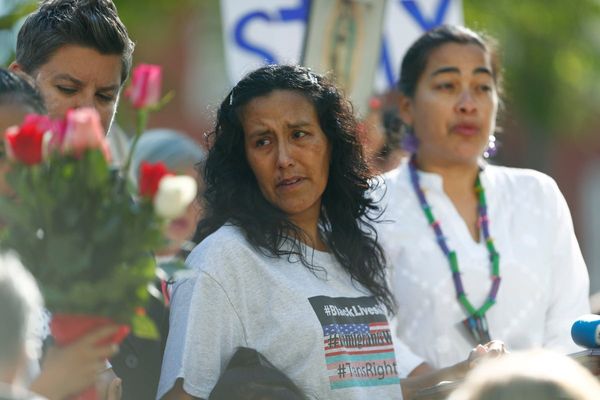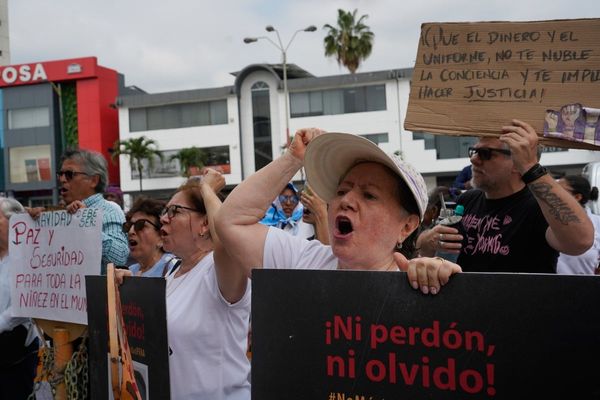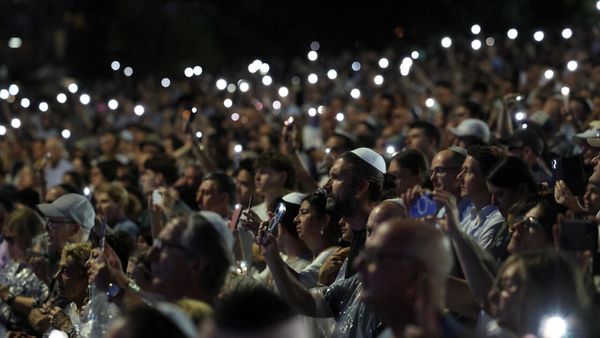
Only one in four detainees from Gaza are identified as fighters by Israel’s military intelligence, classified data indicates, with civilians making up the vast majority of Palestinians held without charge or trial in abusive prisons.
Those jailed for long periods without charge or trial include medical workers, teachers, civil servants, media workers, writers, sick and disabled people and children.
Among the most egregious cases are those of an 82-year-old woman with Alzheimer’s jailed for six weeks and of a single mother separated from her young children. When the mother was released after 53 days she found the children begging on the streets.
The Sde Teiman military base at one point held so many sick, disabled and elderly Palestinians that they had their own hangar, dubbed “the geriatric pen”, a soldier serving there said.
The scale of civilian detention indicated by Israel’s own data has been revealed in an investigation by the Guardian, the Israeli-Palestinian publication +972 Magazine and the Hebrew-language outlet Local Call.
Israeli military intelligence keeps a database of more than 47,000 named individuals whom it classifies as Hamas and Palestinian Islamic Jihad fighters.
Commanders consider it the most accurate information Israel has on enemy forces, according to multiple intelligence sources. It is based on information including files captured from Hamas, updated regularly and includes names of new recruits.
In May this year the database listed 1,450 individuals in detention, whose files were marked “arrested”. That is equivalent to just one in four of all Palestinians from Gaza held in Israeli jails on suspicion of militant links since 7 October 2023.
At that point in May Israel had detained 6,000 people under its “unlawful combatants” legislation, which allows indefinite imprisonment without charge or trial, official data released after legal appeals showed.
Israel is also holding up to 300 Palestinians from Gaza suspected of taking part in the 7 October attacks. They are in criminal detention because Israel says it has sufficient evidence to prosecute them, although no trials have been held.
Both rights groups and Israeli soldiers have described an even smaller ratio of fighters to civilians. When photos of Palestinians stripped and shackled caused international outrage in late 2023, senior officers told Haaretz newspaper that “85 to 90 per cent” were not Hamas members.
The Gaza-based Al Mezan Center for Human Rights has represented hundreds of civilians held in Israeli jails. “We believe the proportion of civilians among those detained is even higher than Israel’s own figures suggest,” said Samir Zaqout, Mezan’s deputy director.
“At most, perhaps one in six or seven might have any link to Hamas or other militant factions, and even then, not necessarily through their military wings.”
Israel’s military said it had returned more than 2,000 civilian detainees to Gaza after finding no connection to militant activity. Israel was fighting enemies who “disguise themselves as civilians”, but those releases demonstrated “a thorough review process” for detentions, the military said in a statement.
It did not dispute the existence of the database or the figures for May, but claimed that “most” detainees were “involved in terrorist activities”.
In May 2,750 Palestinians were permanently interned as unlawful combatants, and another 1,050 had been released under ceasefire deals, the military said.
Israeli politicians, the military and the media often refer to all detainees as “terrorists”.
That includes Fahamiya al-Khalidi, an 82-year-old with Alzheimer’s who was abducted with her female carer in Gaza City in December 2023, and held in Israel for six weeks under the unlawful combatant law, prison documentation shows.
She was disoriented, could not remember her age and thought she was still in Gaza, according to a military medic who treated her in Anatot detention centre after she injured herself on a fence.
“I remember her limping badly toward the clinic. And she’s classified as an unlawful combatant. The way that label is used is insane,” the medic said. Photographs confirm his presence at Anatot at the time.
The Israeli military said Khalidi was targeted “based on specific intelligence concerning her personally”, but the arrest should not have gone ahead.
“The detention was not appropriate and was the result of a local, isolated error in judgment,” the military said, adding that “individuals with medical conditions or even disabilities can still be involved in terrorism”, citing Hamas’s former military chief Mohammed Deif.
Israel’s unlawful combatants legislation allows indefinite detention without producing evidence in open court.
The state can hold someone for 75 days before allowing access to a lawyer and 45 days before bringing them in front of a judge to authorise the detention. At the start of the war, those periods were extended to 180 and 75 days respectively. There have been no known trials of anyone captured in Gaza since 7 October 2023.
Tal Steiner, the director of the Public Committee Against Torture, said: “As soon as the wave of mass arrests began in Gaza in October 2023, there was serious concern that many uninvolved people were being detained without cause.
“This concern was confirmed when we learned that half of those arrested at the beginning of the war were eventually released, demonstrating that there had been no basis for their detention in the first place.”
State figures on the number of unlawful combatants were given to the group after it launched a lawsuit. One soldier who served at Sde Teiman military prison, which became notorious for abuse, described mass detentions of elderly and severely ill people.
“They brought men in wheelchairs, people without legs,” he said, adding these detainees were sent to a “geriatric pen”. “I always assumed the supposed excuse for arresting patients was that maybe they had seen the hostages or something.”
Hassan Jabareen, the director of the Palestinian legal rights group Adalah said Israel’s unlawful combatants legislation was “designed to facilitate the mass detention of civilians and enforced disappearances”.
“It strips detainees of protections guaranteed under international law, including safeguards specifically intended for civilians, using the ‘unlawful combatant’ label to justify the systematic denial of their rights.”
The military medic who treated Khalidi said he also treated a woman bleeding heavily after a miscarriage and a breastfeeding mother who had been separated from her baby and asked him for a pump to stop her breast milk from drying up.
Abeer Ghaban, 40, who was held with Khalidi inside Israel, was separated from her daughter aged 10, and two boys aged nine and seven, when she was detained at an Israeli checkpoint in December 2023.
Although officially still married, she was raising them alone, so when she was taken away the children were on their own.
She realised in interrogation that officers had confused her husband, a farmer, with a Hamas member of the same name. One conceded his error after comparing photographs, she said, but she was kept in jail for six more weeks.
Israeli troops deployed to guard Palestinians often opposed releasing civilians cleared of any Hamas links, an Israeli stationed at a military facility said. They wanted to hold them indefinitely as leverage in hostage negotiations.
“We kept releasing people ‘for free’, and it made [soldiers] angry,” the source said. “[The soldiers] would say: ‘They’re not returning hostages, so why should we let them go?’”
Israeli politicians have expressed similar sentiments.
When Mohammed Abu Salmiya, the director of Gaza’s Shifa hospital, was released last year, Simcha Rothman, chair of the Knesset’s constitution, law and justice committee, complained that he was freed “not in exchange for hostages”.
Rights groups suspect this approach has unofficially been a driver of mass detentions throughout the war. “Even before 7 October, Israel withheld the bodies of hundreds of Palestinians, using them as bargaining chips instead of returning them to their families for burial,” said a spokesperson for Al Mezan.
“We believe the thousands of civilians from Gaza now in detention are likewise intended to be used as bargaining chips.”
The majority of people held as unlawful combatants are also effectively kept incommunicado, deepening anguish for both those in jail and their loved ones in Gaza.
When Ghaban was released, she found her children begging in the street. “They were alive, but seeing the state they had been in for 53 days without me broke me,” she said. “I wished I had remained in prison rather than seeing them like that.”
The unlawful combatants legislation has been used to facilitate the “forced disappearance of hundreds and even thousands of people”, said Jessica Montell, the director of the legal rights organisation HaMoked.
Nesreen Deifallah spent months searching for her 16-year-old son, Moatasem, who went to look for food on 3 December 2024 and never came home, even checking decomposed corpses in hospital morgues in case she recognised his clothes.
In August a recently freed detainee told Deifallah he had been held with Moatasem. “I fainted when I learned that my son was still alive,” she said. Still she cannot confirm where he is, or contact Moatasem, who was sick, according to the man.
By August Israel’s prison service held a record 2,662 unlawful combatants, data obtained by HaMoked showed. An unknown number more are in military detention facilities.
One Israeli officer who led mass arrest operations in Khan Younis said soldiers saw no difference “between a terrorist who entered Israel on 7 October and someone working for the water authority in Khan Younis”.
The best public interest journalism relies on first-hand accounts from people in the know.
If you have something to share on this subject you can contact us confidentially using the following methods.
Secure Messaging in the Guardian app
The Guardian app has a tool to send tips about stories. Messages are end to end encrypted and concealed within the routine activity that every Guardian mobile app performs. This prevents an observer from knowing that you are communicating with us at all, let alone what is being said.
If you don't already have the Guardian app, download it (iOS/Android) and go to the menu. Select ‘Secure Messaging’.
SecureDrop, instant messengers, email, telephone and post
If you can safely use the tor network without being observed or monitored you can send messages and documents to the Guardian via our SecureDrop platform.
Finally, our guide at theguardian.com/tips lists several ways to contact us securely, and discusses the pros and cons of each.







